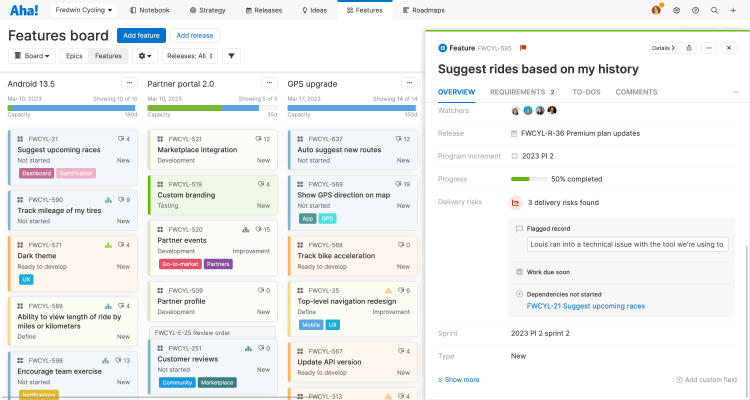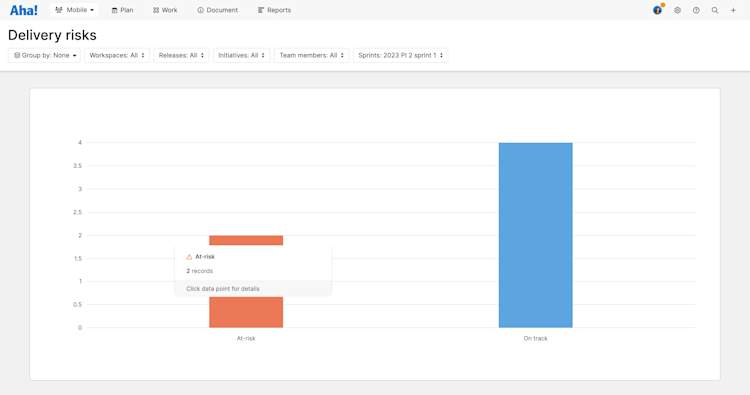Aha! Roadmaps | Manage at-risk work
Delivery risks affect each stage of the product development lifecycle, from planning to development, roadmap to release. Ambitious cross-functional plans come with many critical dependencies — too many for product and development teams to keep top of mind or back of envelope.
This is where automated risk indicators step in. Select any of the 15 separate alerts (including the ability to manually flag a record as at risk), then track your teams' progress in your Aha! account, and step in to mitigate any risk that pops up.

You can enable delivery risk alerts in Aha! Roadmaps or Aha! Develop. Both products work together to create a unified product development environment, where product and development teams share the same Aha! records and can work towards the same goals. They can also create risk profiles unique to their needs, to track important alerts in the planning and development phases of delivery.
If you are using Aha! Roadmaps or Aha! Develop as standalone products, you can still add delivery risk alerts from the Planning or Development setting subsections, respectively. Risk alerts are not mappable over integrations, and with few exceptions third-party integrations cannot affect Aha! risk alerts.
Click any of the following links to skip ahead:
Configure risk alerts
Enable — and configure — the exact risk profile you need to track in your Aha! Roadmaps workspace or Aha! Develop team. To do this, navigate to Settings ⚙️ Workspace/Team Delivery risks.
Enabled: Toggle these risk indicators on or off.
Allow users to flag records: Click this toggle to enable users in your team to flag at-risk work themselves. They can flag any epic, feature, or requirement in your team, and add a comment explaining the risk.
Check records in parking lots: Use this toggle to include records in parking lots in delivery risk alerts.
Planning
These risks typically apply to the planning stage of product development, which can take place in both Aha! Roadmaps and Aha! Develop. Enable as many of these as are useful to your team.
The risk alerts you enable here will apply to any records created by your team in your workspace or team.
Work not scheduled
Work due soon: Select a number of days to define what "soon" means to your team.
Work overdue: Select a number of days to define what "overdue" means to your team.
Release due soon: Select a number of days to define what "soon" means to your team.
Release overdue: Select a number of days to define what "overdue" means to your team.
Development
These risks typically apply to the development stage of product development, which usually takes place in Aha! Develop. Enable as many of these as are useful to your team.
The risk alerts you enable here will apply to any records created by your team in your workspace or team.
No team
No detailed estimate: Records in your Aha! account can have two types of effort estimates. Initial estimates come early in the prioritization process when the work is largely undefined. Detailed estimates come after the work has been scoped and vetted by experts (often including input from an Aha! Develop team).
No assignee
No sprint: This risk alert is most useful to Aha! Develop teams that use sprints.
No program increment: Work has not been assigned to a SAFe program increment.
Started late: Select a number of days to define what "late" means to your team.
Status churn: This risk indicator triggers if a record keeps returning to a previous status instead of progressing through development. Select the number of cyclical status changes that should indicate a record is stuck.
Work stalled: Select a number of days to define how long a record type can stay in a single In progress workflow status before you would consider progress stalled.
Dependencies not started
Dependencies past due: Select a number of days to define what "past due" means to your team.
Sprint rollover: Work have moved from sprint to sprint without being completed. Select the number of sprint changes that should trigger this alert.
Click Update configuration to save your changes.
Add delivery risks to custom record layouts
You have enabled the risk alerts you need; now add the Delivery risks field to the appropriate record layouts. This field will let you see all risks associated with a record, and (if you have enabled it) manually flag and comment on at-risk records.
Navigate to Settings ⚙️ Account Custom layouts. You will need to be an administrator with customizations permissions in either Aha! Roadmaps or Aha! Develop to do this.
Open the record layout for the epic, feature, and/or requirement records in the workspace or team where you have enabled risk indicators.
From the View record layout, click Existing fields.
Search or scroll down to the Delivery risks field, then drag it onto the example custom layout.
Click Save to save your record.
Records that have originated in your workspace or team will now display the risk alerts you enabled in your settings (and show Delivery on track if there are no known risks).
Manually flag a record
Automated risk alerts capture the most common reasons why an Aha! record might be at risk. But since sophisticated workflows can lead to unique risk indicators, you can also manually flag a record as at risk. To do this:
Make sure you have added the Delivery risks field to your custom layout.
Open a record you think is at risk of missing its delivery date.
In the Delivery risks field, click Flag record.
(Optional) Click Add comment to explain why you flagged the record.
You can customize record cards in your workspace or team to indicate whether a record has been manually flagged, and report on manual flags (and comments). If a risk has been resolved, open the record and click Remove flag beside the manual flag.
Remove flag will also delete any comment on the manual record flag.
Highlight risks with card customizations
Get alerted to at-risk work in context. Customize record cards on the Aha! pages where your team spends the most time.
In Aha! Roadmaps:
In Aha! Develop:
You can add four types at-risk indicators to your cards:
Flag symbol: Indicates that a record has been manually flagged as at-risk.
At risk: Indicates that an automated risk indicator has triggered for this record.
At risk symbol: Indicates that an automated risk indicator has triggered for this record.
Stopwatch symbol: For records in an Aha! Develop team. Lists the time that a record has been in its current In progress status. Use it to check whether a time-based risk indicator (such as Started late or Dependencies past due) has triggered for this record.
Report on at-risk work
Risk indicators do more than keep individual records on track. Taken together, they uncover workflow bottlenecks, overly-optimistic delivery schedules, and over-tasked or struggling teammates. Report on risk indicators to analyze high-level risks that your plans are exposed to — and start the insightful conversations that will help you deliver on time with confidence.

Your primary tool in this effort is the delivery risk report. Available to Aha! Develop Advanced plan customers, the delivery risks report highlights all records in a sprint that have been automatically or manually flagged as at risk. Thanks to alerts on the program increments view, this report is especially effective for teams that use the Scaled Agile Framework® (SAFe) for planning and delivering software. But any team that uses sprints will see significant benefits.
The delivery risks report separates work into At risk or On track, so you can sort records in your selected sprint(s) at a glance.
Filter the report to include specific records, and to group work by Release, strategic Initiative, Aha! Roadmaps Workspace, individual Aha! Develop Team member, or Sprint.
Hover over any column in the report to see the status, sprint, and record count of that data point.
Click on a section of the report to generate a pre-built list report of all records in that sprint. Click on any record to open a drawer view and adjust details. The report will update automatically with any new information.
Then, start conversations.
If a record was automatically flagged, was the risk alert appropriate? Does it indicate broader workflow or process trouble?
If a record was manually flagged, discuss it. Is a teammate over capacity? Is there a dependency here that has not been documented?
You can also use the full suite of Aha! reports to follow your curiosity. Both Aha! Roadmaps and Aha! Develop include list reports, pivot tables, and charts. Use these to visualize risks, update manually flagged records, and track your team's risk exposure over time.
Remember, you can only report on risks indicators that you have enabled for records created in your workspace or team. Use the [Record] delivery risks field for a summary of all risks on a given record.
Use the [Record] at risk: [Risk] fields to track individual risk indicators.
Use the [Record] at risk: Flagged record comment field to include comments on manually flagged records.
Because work in Aha! Develop can span epics, features, and requirements — all in the same sprint or on the same workflow board — you can use the Epics, features, requirements table to pull all these Aha! Develop records into one report or chart.
Link risk indicators with linked work to stay on top of critical dependencies.
Use the [Record type] record links table in any list, pivot, or chart report (or custom roadmap!). Then, add the Linked [record type] table and select any field (like Status, Assignee, or Due date) on the linked record's layout.
For a focused view of critical dependencies, filter these reports to show only records with Depends on/Dependency of relationships. You can also add information about manual and automatic risk indicators. Then, add your filtered report as a dashboard panel.